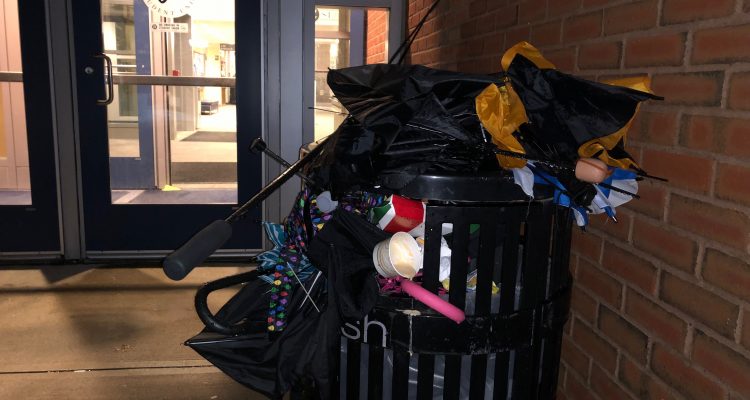By Ally Urban
UConn’s trash receptacles played host to numerous broken and subsequently discarded umbrellas last Thursday, January 24.
Thanks to the strong winds constantly swirling around campus that day, many umbrellas are, ironically, unusable during rainy weather, to the dismay of students who chose to use them.
Due to UConn’s size, it may take students quite a while to traverse the campus when walking from class to class, or to and from their dorms.
The walk from Towers Dorms to the center of campus is certainly a hike; the same goes for people living in Charter Oak apartments, or the Oaks. It’s even worse when one’s classes are all over campus.
Add a heavy downpour and unrelenting wind, and there’s a recipe for a miserable commute to class.

Although the UConn bus system is an option, not everyone opts to use it. Many students choose to brave the weather, and hope that their laptops, notes, and other electronics won’t get soaked in a raging monsoon, even with umbrellas.
UConn Bookstore manager Leonard Oser says, “We do get a spike in umbrella sales when it rains, mostly from people that have forgotten to take one to class or work. We might sell a few dozen when it rains that hard.”
In order to get more insight about the mangled umbrella epidemic, a poll was conducted on the student Facebook group “Buy or Sell UConn Tickets”. The two questions asked in this poll were whether or not the student’s umbrella broke, and if the student purchased an umbrella from the UConn Bookstore or Student Union Convenience store, with yes/no options for each.
The result of the poll are as follows:
84 people answered yes to their umbrella being broken and 40 answered no.
9 answered yes to buying a new umbrella and 86 answered no.
Additionally, students added a few of their own rather comical categories as answers. UConn student Sadie Rumsey added the most popular vote which was, “I learned many moons ago that umbrellas are useless on this campus.” This option received 209 votes. Another said, “Buy an inside-out umbrella so when the wind flips it it’s just almost closed.”

Destroyed umbrellas are shoved into a trash can outside the Student Union.
Photo: Daniela Doncel
Outside the scope of student reactions, trashed umbrellas also pose an impact on the environment.
Modern umbrellas are generally made from nylon, stainless steel and plastic, according to Umbrella Components. They could also contain aluminium, fibreglass, wood or carbon parts. According to Green Choices, nylon is non-biodegradable, and “nylon manufacture creates nitrous oxide, a greenhouse gas 310 times more potent than carbon dioxide”.
On the other hand, stainless steel has “theoretically 100% recyclability and its long term life makes it an ideal environmental performer much better than many other materials”, writes the British Stainless Steel Association.
In order to combat unfavourable environmental effects, numerous companies such as Brelli and ShedRain have created eco-friendly umbrellas.
Brelli describes their umbrellas as being able to “biodegrade in aerobic and anaerobic landfill environments. In an aerobic landfill it will biodegrade as twigs and leaves do.”
Ultimately, although bad weather causes many umbrellas to retire to the graveyard, companies are offering more options to reduce the carbon-footprint left by these rain-repellent devices.


